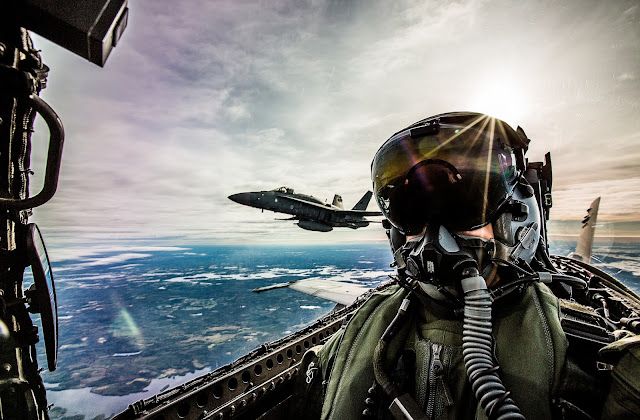As noted before, the USMC's and FINAF's Hornets are externally pretty similar. I am emphasizing the word externally. The ejection seats in the Finnish Hornets are modified to have a quick-release-fitting and the belts and straps are integrated to the seat. The USMC pilots use the harness. Apparently the Finnish system has been discovered to be better because the newer fighters’, like the F-35's, are equipped with a similar system.
Even though I already knew the majority of the training, it was a very good refresh training. Some of the classes went a little deeper than the in the Finnish Air Force trainings, but most of the stuff was pretty similar. One thing I noted was the instructors taught every class with such a passion. Even the very basic physiology classes felt very interesting. Nobody started their lectures with, "Well, I was ordered to give this class, so let's see what the PowerPoint slides have here..." Everybody was so excited about their classes and they taught them like the classes were the most important thing in the world. Even though it was very very far from it. I respect that.
After a couple of days of theory, we did a short hypoxia simulator flight. It was a good introduction to hypoxia but it could have been more thorough. Recognizing the problems with your oxygen system is absolutely crucial. According to the Navytimes.com website, the Navy and the Marine Corps have over 100 hypoxia incident every year due to the OBOGS systems. Especially when the aircraft are getting older, it is essential to know what kind of symptoms you will encounter when you are hypoxic. This allows you to execute the needed emergency procedures and land the airplane safely before anything happens.
When you are hypoxic, your performance will deteriorate drastically. The pilot's useful time of consciousness may be no more than a few seconds, so he or she has to execute the emergency procedures very quickly after recognizing the symptoms. In the simulator you can safely train these under supervision.
During the last few years, it seems the Americans have started to pay more attention to other countries as well. The locals joke about how ”stupid and ignorant” they are regarding foreign countries. But you have to remember, that USA is only 3% smaller in area than the whole Europe, so they have a lot to deal with in their own country already.
For us Finns, there is a lot to improve in our social skills. Even though I'm already pretty familiar with the American culture, I still get surprised every now and then when a total strangers say something like "How's it going?" or "How are you?" on the street. We never do that in Finland. We hardly even make eye contact if we don’t know each other . I envy how natural it is for the Americans to start a little small talk, which can be very tricky for us Finns.
Our training in NAS Pensacola culminated in the "Helo Dunker". It is a simulated helicopter crash into water where you have to get safely escape the helicopter underwater. We executed the training twice during the day and once during the night, which was simulated by dark goggles. It was a very good reminder how important it is to be familiar with the emergency exits and actually know how to operate the exit handles. They are quite hard to find only by hand, especially if it’s the real deal. These checks should always be done beforehand, not when the emergency is in process. One of the Helo Dunker phases can be watched here.
 |
| Training in progress. |








